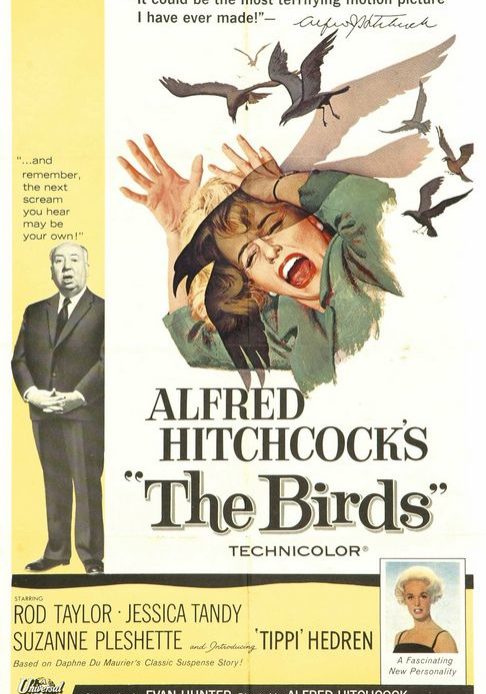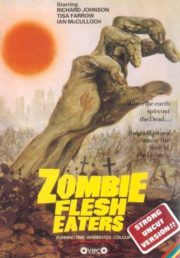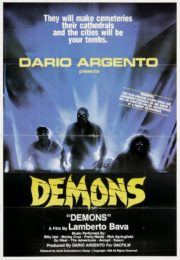“Nature’s Malevolent Ballet”: An Ominous Review of ‘The Birds’
“I hardly think a few birds are going to bring about the end of the world.” These words, spoken in Alfred Hitchcock’s ‘The Birds,’ could not be more ironic as they precede one of cinema’s most unnerving and eerie horror films. Released in 1963, the master of suspense, Hitchcock, unleashes upon the unassuming audience a chiller that turns the mundane into the menacing. The film follows the story of Melanie Daniels (Tippi Hedren), who ends up in the quaint town of Bodega Bay pursuing a romantic connection, only to find herself amidst inexplicable and violent bird attacks that terrorize the community.
Whispers of Dread: Atmosphere and Tone in ‘The Birds’
The horror in ‘The Birds’ is no creature feature relying on grotesque visuals; instead, Hitchcock crafts an ambiance of pervasive dread. It is a film that thrives on suspense and the anxiogenic sense that anything could happen at any moment. There’s an escalating foreboding sensation as everyday events gradually become infused with threat. The true masterstroke lies in the juxtaposition of normalcy with the unspeakable horror that follows, leaving viewers teetering on the edge of their seats.
As the narrative progresses, so does the intensity of the encounters with the avian antagonists. Hitchcock’s manipulation of tension is a slow burn—a meticulous construction of fear that isn’t reliant on jump scares. The omnipresent sense of danger emanates as much from the silences and pauses as from the attacks, demonstrating Hitchcock’s unmatched ability to control audience emotions.
Eye of the Storm: Cinematography and Sonic Terror
Visual Imprinting
The cinematography in ‘The Birds’ is a series of haunting images sewn into the fabric of horror legacy. The use of color is stark; technicolor domestic scenes cast a deceptive veil of normalcy, while the attacks are underscored by a gloomy palette. Camera angles and movements build palpable tension, with unusual perspectives giving viewers a sense of disorientation reflective of the characters’ turmoil.
Special effects, revolutionary at the time, bring the birds to life in a terrorizing ballet. The attack sequences are a blend of live-action shots, mechanical effects, and matte paintings, creating scenes of chaos that hold up even by modern standards.
Soundscape of Horror
More than visuals, it’s the experimental soundtrack and sound effects in ‘The Birds’ that etch themselves into the psyche. The absence of traditional music heightens the realism of the film, with electronic sounds and manipulated bird cries giving voice to the otherwise musically silent motion picture. When the birds gather, a frenzied cacophony predicts doom, but it’s the quiet moments—deceptively serene—that somehow resonate louder.
Living Nightmares: Characters on the Brink
Performances in ‘The Birds’ are intrinsic to the film’s mounting horror. Tippi Hedren’s portrayal of Melanie Daniels offers both the steely grace of a socialite and the visceral fear of a woman pushed to her limits. Supporting characters, such as the stoic and protective Mitch Brenner (Rod Taylor) and the anxious mother Lydia Brenner (Jessica Tandy), add to the layered human element amidst the chaos. Their reactions to terror, both restrained and unhinged, construct a believable tapestry of a town under siege.
The characters are not just fodder for the feathered fiends; they are emotionally complex and react in ways that audiences can empathize with, which serves to root the horror in reality. Their evolution over the narrative arc from complacent to terrified helps elevate the film from pure shock to a poignant tale of survival.
Apocalyptic Aviary: ‘The Birds’ Under the Horrific Lens
The Fusion of Horror Conventions
Hitchcock’s film doesn’t neatly fit within a single subgenre of horror—instead, it borrows from psychological and natural horror, and even aspects of the supernatural, defying traditional classification. It challenges the viewer to confront a possible reality where nature rebels against humanity, a terror that is both visceral and cerebral.
Techniques That Terrify
The methods used in ‘The Birds’ to frighten the audience are predominantly psychological. The lack of explanation for the birds’ behavior leaves much to the imagination, a fear of the unknown that is arguably more powerful than any explicit gore. Sudden shocks are used sparingly, and thus, they hit harder—the first swift attack on Melanie is both stunning and horrifying in its abruptness. These techniques are executed with surgical precision, and have left a lasting impression on the genre.
Themes and Societal Commentary
Amongst its many accomplishments, ‘The Birds’ excels in exploring deeper issues. The film can be seen as a parable about nature’s unpredictability and our own vulnerability within it. Hitchcock’s classic also examines human dynamics and relationships under stress, adding layers of depth to the terror experienced on a more visceral level.
Concluding the Fright: ‘The Birds’ in Retrospect
Alfred Hitchcock’s ‘The Birds’ is a triumph of horror cinema that continues to influence and terrify. Its innovation in storytelling and production solidify its status as more than just a chilling tale—it is a thought-provoking commentary on human fragility. From its technical prowess to the strength of its ensemble cast, ‘The Birds’ remains genuinely frightening and captivating.
Horror aficionados and cinephiles alike will appreciate the artistry and suspense of the film. However, its slow build and psychological focus might temper its appeal for viewers seeking the instant gratification of modern jump-scare laden horror. With no extreme gore or graphic content, the movie unites a broad spectrum of viewers in the shadow of its wings.
When placed alongside classics and contemporary horror films, ‘The Birds’ endures as an innovative pioneer. Its strengths far outweigh any perceived weaknesses, such as slower pacing by today’s standards. Overall, ‘The Birds’ retains a perch high in the pantheon of horror—captivating, unnerving, and as relevant as ever.




